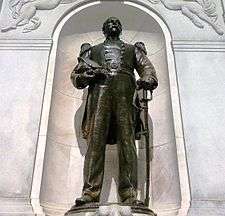George H. Perkins

Commodore George Hamilton Perkins (20 October 1836 – 28 October 1899) was an officer in the United States Navy during the American Civil War.
Biography
Born in Contoocookville, New Hampshire in the northern part of Hopkinton to the Honorable Hamilton Eliot Perkins, George was appointed as Acting Midshipman in October 1851 and graduated from the U.S. Naval Academy with the class of 1856. During the rest of that decade Midshipman Perkins served on at sea on the sloop of war Cyane, the storeship Release and the steamer Sumpter. He attained the ranks of Master in 1859 and Lieutenant in February 1861, on the eve of the Civil War. Perkins spent the conflict's first several months in the Sumpter, operating on anti-slavery patrols. In late 1861 he became Commanding Officer of the new gunboat Cayuga, in which he performed distinguished service during the 1862 campaigns to capture New Orleans and the lower Mississippi River.

He was next Executive Officer of the steam sloop Pensacola, receiving promotion to Lieutenant Commander at the end of 1862. His service on the Mississippi and in the Gulf of Mexico continued in 1863-1865, including command of gunboats New London and Sciota, and the monitor Chickasaw. While in the latter ship, his aggressive and effective conduct during the August 1864 Battle of Mobile Bay was a major factor in the capture of the Confederate ironclad Tennessee.
In the years immediately following the Civil War Lieutenant Commander Perkins was Superintendent of Iron-Clads at New Orleans, Executive Officer of the steam sloop Lackawanna in the North Pacific, and had ordnance duty at the Boston Navy Yard. Reaching the rank of Commander in early 1871, he spent the next decade as Commanding Officer of the storeship Relief and gunboat Ashuelot and had further shore duty at Boston.
Perkins was promoted to Captain in 1882 and commanded the Pacific Station flagship USS Hartford during the mid-1880s. Captain Perkins' subsequent active service was limited to court-martial duty. He was transferred to the Retired List in October 1891, but in 1896 received a Congressionally authorized promotion to the retired rank of Commodore in recognition of his gallantry and skill during the Battle of Mobile Bay three decades earlier. Commodore Perkins died at Boston on 28 October 1899.
Family

The commodore married a daughter of William Fletcher Weld, a multimillionaire from Boston's famous Weld Family.
Their daughter, Isabel Weld Perkins, married Larz Anderson, a wealthy businessman who served as Ambassador to Japan under William Howard Taft. Among the homes they maintained was Perkins Manor, the commodore's birthplace.
The Andersons' legacy to the public includes Anderson House, Anderson Memorial Bridge, Larz Anderson Auto Museum, Larz Anderson Bonsai Collection and Larz Anderson Park.
Ships named after Perkins
The U.S. Navy has named three destroyers in honor of George H. Perkins, including:
- USS Perkins Destroyer # 26, later DD-26 of 1910-1935
- USS Perkins (DD-377) of 1936-1943
- USS Perkins (DD-877, later DDR-877 and DD-877) of 1945-1973.
References
- Perkins Manor, Contoocook Village Quilt
- Project Gutenberg EBook of The Bay State Monthly - Volume 1, Issue 4, April, 1884
- Cornell University Library photos of The Bay State Monthly - Volume 1, Issue 4, April, 1884
- Attribution
 This article incorporates public domain material from websites or documents of the Naval History & Heritage Command.
This article incorporates public domain material from websites or documents of the Naval History & Heritage Command.
External links
-
 "Perkins, George Hamilton". Appletons' Cyclopædia of American Biography. 1900. This source gives his birthday as December 20.
"Perkins, George Hamilton". Appletons' Cyclopædia of American Biography. 1900. This source gives his birthday as December 20.